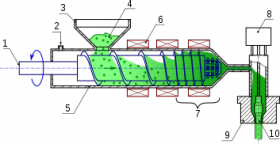EBM
In Extrusion Blow Moulding (EBM), plastic is melted and extruded into a hollow tube (a parison). This parison is then captured by closing it into a cooled metal mold. Air is then blown into the parison, inflating it into the shape of the hollow bottle, container, or part. After the plastic has cooled sufficiently, the mold is opened and the part is ejected. Continuous and Intermittent are two variations of Extrusion Blow Molding. In Continuous Extrusion Blow Molding the parison is extruded continuously and the individual parts are cut off by a suitable knife. In Intermittent blow molding there are two processes: straight intermittent is similar to injection molding whereby the screw turns, then stops and pushes the melt out. With the accumulator method, an accumulator gathers melted plastic and when the previous mold has cooled and enough plastic has accumulated, a rod pushes the melted plastic and forms the parison. In this case the screw may turn continuously or intermittently. with continuous extrusion the weight of the parison drags the parison and makes calibrating the wall thickness difficult. The accumulator head or reciprocating screw methods use hydraulic systems to push the parison out quickly reducing the effect of the weight and allowing precise control over the wall thickness by adjusting the die gap with a parison programming device.
EBM processes may be either continuous (constant extrusion of the parison) or intermittent. Types of EBM equipment may be categorized as follows:
Continuous extrusion equipment
- rotary wheel blow molding systems
- shuttle machinery
Intermittent extrusion machinery
- reciprocating screw machinery
- accumulator head machinery
Examples of parts made by the EBM process include most polyethylene hollow products, milk bottles, shampoo bottles, automotive ducting, watering cans and hollow industrial parts such as drums.
Advantages of blow molding include: low tool and die cost; fast production rates; ability to mold complex part; Handles can be incorporated in the design.
Disadvantages of blow molding include: limited to hollow parts, low strength, to increase barrier properties multilayer parisons of different materials are used thus not recyclable. To make wide neck jars spin trimming is necessary
Spin trimming
Containers such as jars often have an excess of material due to the molding process. This is trimmed off by spinning a knife around the container which cuts the material away. This excess plastic is then recycled to create new moldings. Spin Trimmers are used on a number of materials, such as PVC, HDPE and PE+LDPE. Different types of the materials have their own physical characteristics affecting trimming. For example, moldings produced from amorphous materials are much more difficult to trim than crystalline materials. Titanium coated blades are often used rather than standard steel to increase life by a factor of 30 times.

